Final report for GNC17-247
Project Information
Sod farmers and professional turf managers in the Midwest are facing an increasing problem with billbugs, a tiny weevil (beetle) that can damage turf in both its larval and adult stages. Small billbug larvae feed within the grass stems and then eventually burrow down to the soil and feed the roots and crowns when they become bigger.
Conventional control practices rely heavily on using insecticides, which usually require repeat, broadcast applications in spring and fall. The failure of chemicals being able to control of billbugs is partially due to the difficulty of delivering insecticides to where the billbugs are, and not surprisingly, this has resulted in the spread of billbugs and an increase in their populations in localized areas. As a consequence, sod farmers and professional turf managers have started to use higher dosages of insecticides with increased application frequencies. The proposed research, instead, will examine a novel approach to remove the adult billbug from the affected turf. As a nocturnal species, billbug adults come up to the turf surface in the night and engage in various activities including feeding and mating. Using professional turf sweepers, we can specifically target on the billbugs and remove them from the affected turf, and hence control the pest by interrupting their life cycles. The proposed experiment was carried out at a local golf course in Columbia, Missouri. Treatments, including mechanical control using sweeper, and a conventional insecticide control program and a non-treated control, were arranged in a randomized complete block design with four replications. Individual plot size were 9m × 30m and placed 10 meters apart to minimize possible re-introduction of billbugs into the treated-plots. In addition to turf performance which was detected using a handheld sensor, weekly monitoring of billbug adult populations were performed by installing and monitoring ten pitfall traps randomly in each plot. The expected outcome was the development of a strategy for control of billbugs that minimize insecticide application to turf areas.
This project aimed to develop a billbug control method using mechanical approach, and consequently reduce insecticide application and costs associated with repeated use of insecticides.
Cooperators
- (Researcher)
Research
Field experiments was performed at the A.L. Gustin Golf Course at Columbia, Missouri. The sod farmer who operates a sod farm near Jefferson City, Missouri, wanted to support this project but not at this farm. Plots were established on a zoysiagrass fairway where billbug damage has historically been documented. The experimental treatments, including mechanical removal of billbug adults (“Mechanic method”), application of insecticide (“Chemical method”), and a non-treated control (“Control”) were arranged in a randomized complete block design with four replications. Individual plots, measuring 9m × 30m, were established 10 meters apart from each other. This arrangement allowed the LitterKat® turf sweeper (GreensGroomer WorldWild, Inc., Indianapolis, IN) and spraying boom, both measuring 3 meters in width, to go through individual plot in 3 passes. Plots size design also considered adult billbug movement in order to minimize the possible re-introduction of billbugs into the treated-plots, and was based on a reported mean 0.7 meter movement of a billbug per day coupled with an average of 10-day lifespan for adults.
The plots were surrounded by linear pitfall traps. Additionally, pitfall traps were installed randomly inside each plot. The pitfall traps were made using PVC slip cap that was 7.6 cm long, 8.9 cm inside diameter, and 10.0 cm outside diameter. A hole was drilled at the bottom of the cap to allow drainage, and a round drain strainer with 8.0 cm diameter and 0.3 cm perforations was placed into the slip cap. A 2.5 cm, number 10 screw was then inserted into the center of the drain strainer to plug a 0.5 cm hole in the middle. The pitfall traps were installed just below the soil surface in turf after removing soil cores using a cup cutter with 10.0 cm diameter. Once established, the pitfall traps were monitored every week, and the trapped billbug specimens were counted, recorded, and stored separately by each plot at 4 ℃ for future diagnosis to species in the laboratory.
The Mechanic method, using the LitterKat® turf sweeper to remove billbug adults, was performed in the evening hours after 9pm, during periods of peak adult active times. The evening timing for performing sweeping was determined based upon our previous experience of scouting and collecting billbug adults (up to 200+ in 50 min) on infested turf surface, due to their nocturnal nature. Our previous experiments also determined the occurrence of two adult peak activities in our region, with the first peak occurring in the fall (beginning in late July) and the second in the spring (starting in late April). Sweeping was occur at nights, nine times in the fall of 2017 (at 3 trips/week for 3 weeks) and six times in the spring of 2018 (at 3 times/week for 2 weeks). LitterKat® was utilized to sweep the designated plots in 3 passes, collected billbugs were bagged per plot and stored under the condition described above for counting and diagnosing to species. Chemical control using insecticide, bifenthrin (Talstar®; FMC Professional Solutions, Philadelphia, PA) at 5 fl oz/1,000 ft2, was applied once in fall (August, 23, 2017), and once in spring. As an adulticide, application of bifenthrin in our previous experiment resulted in the least turf damage over a two-year period. Application were performed at the peak adult active times at the label suggested rate. In addition to monitoring billbug adults trapped in the pitfall traps on a weekly basis, turf quality detected by using a GreenSeeker® hand-held sensor (NTech Industries, Inc., Ukiah, CA) was carried out to generate normalized difference vegetation index (NDVI) during this project .
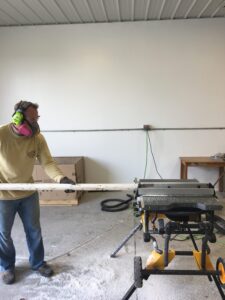
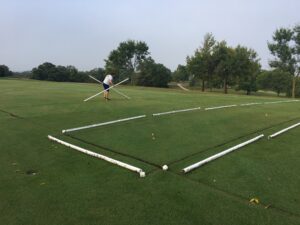
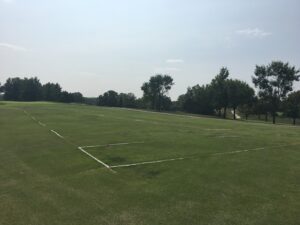
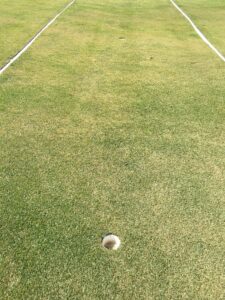
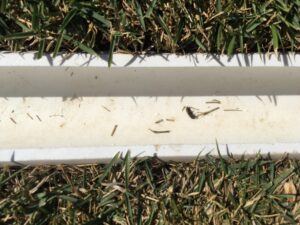
The LitterKat® Turf Sweeper used to sweep the designated plots three times each week during a 3-week period in August, 2017, and again in a 2-week period in May, 2018. A total of 15 evening sweeping events were carried out, with 9 of the sweepings took place in fall 2017, and the rest of 6 events occurred in spring 2018. These three weeks in 2017 and two weeks in 2018 were identified as the peak periods when billbug adults were engaged in various activities on the turf surface in the evening hours, such as mating (Huang and Buss, 2009). All sweepings were performed in the dark after 9:30 PM in the evening.
The total amount of billbugs that were removed from the 4 replicate plots over a total of 15 sweeping events were 483, with an average of 120.75 per plot. At each sweeping event, the amount of billbugs that were removed from the four replicate plots ranged from 104 to 3 (Table 1). On average, billbugs removed varied from 26 per plot to 0.8 per plot from each sweeping event (Fig 6). A close look revealed that the adult billbugs caught by the sweeper showed a gradual and steady decreasing trend from fall of 2017 to spring of 2018 (R2=0.9115). This result suggested a declining population of billbugs overtime. As the plots were surrounded by linear pitfall traps that prevented billbugs in the surroundings from entering the plot area, this declining in population is most likely attributed to the sweepings that removed individual billbugs from the plots.
Turf performance was monitored using a hand-held GreenSeeker® sensor which scans the turf canopy and generates normalized difference vegetation index (NDVI). The NDVI value generally varies between 0 to 1 from a turf surface, and greater the value, greener and denser the turf canopy (Xiong, et al., 2007). Turf performance determined as NDVI during August 2017, when adult billbugs were active and sweepings were carried out, showed no differences regardless treatments (Fig 7). This is to be expected as the larvae stage, not the adults, of the billbugs are considered the most detrimental stage that causes turf damage (Huang, et al., 2014).
After the eggs have hatched and larvae started feeding during September, October and November of 2017, however, treatments applied significantly influenced the turf performance with plots that have been swept in August showed the best turf quality (Fig 8A). This result corroborates with the reduced billbug population following sweeping, and collectively suggests a direct correlation between sweeping and turf quality improvement. It is also intriguing to find that plots receiving insecticide application resulted in numerically, the lowest turf quality among all treatments. It is known that insecticide application might affect beneficial species (Kunkel, et al., 2001), however, its negative impact on turf quality/performance has not yet been established. In our experiment, bifenthrin was applied and its effectiveness for control of adult billbugs has been well-documented (Richmond, 2015). Therefore, the reason why insecticide-applied plots did not show the benefits from billbug control and hence turf quality improvement, instead a reduced quality, is unknown. As winter approaches, turf quality, indicated by NDVI, showed a decrease (Fig 8B). This is anticipated because zoysiagrass is a C4 plant which enters dormancy during winter months in the transition zone. When spring returns, zoysiagrass starts to regrowth at no difference in NDVI were found among treated plots in May 2018 (Fig 9).
In summary, our results suggest that sweeping in fall in the evening hours when adult billbugs are active on the turf surface is an effective approach in removing billbug individuals. Results from this experiment also strongly suggest that this mechanical approach substantially reduces the billbug population sizes and ultimately, improves turf quality. As this was a one-year project, effects of spring sweepings when the adult activity typically reaches a smaller peak than the fall, was not fully understood. Nevertheless, our experiment demonstrates the potential of using a mechanic sweeper to control billbugs without using insecticides. Research in the future should focus on developing integrated programs that incorporate mechanic methods like this for effective pest control with sustainable, and environment-friendly approaches.
Reference:
Huang, T., and E. A. Buss. 2009. Billbug (Coleoptera: Curculionidae) species composition, abundance, seasonal activity, and developmental time in Florida. J. Econ. Entomol. 102: 309-314.
Huang, T., O. Kostromytska, K. E. Kenworthy, and E. A. Buss. 2014. Zoysiagrass genotype responses to Sphenophorus venatus vestitus (Coleoptera: Curculionidae). J. Econ. Entomol. 107: 1535-1542.
Kunkel, B.A., D.W. Held, and D.A. Potter. 2001. Lethal and sublethal effects of bendiocarb, halofenozide, and imidacloprid on Harpalus pennsylvanicus (Coleoptera: Carabidae) following different modes of exposure in turfgrass. Ecotoxicology. 94: 60-67.
Richmond, D.S. 2015. Managing billbugs in turfgrass. Turfgrass Insects. Purdue Extension Publication E-266. Online. https://extension.entm.purdue.edu/publications/E-266/E-266.pdf.
Xiong X., G. E. Bell, J. B. Solie, M. W. Smith, and B. Martin. 2007. Bermudagrass seasonal responses to N fertilization and irrigation detected using optical sensing. Crop Science. 47: 1603-1610.
Table 1. Number of billbugs removed by each sweeping event from each replicate plot.
|
Replication |
8/18/17 |
8/19/17 |
8/20/17 |
8/22/17 |
8/23/17 |
8/24/17 |
8/28/17 |
8/29/17 |
8/30/17 |
5/8/18 |
5/10/18 |
5/12/18 |
5/15/18 |
5/16/18 |
5/18/18 |
Total |
|
Rep 1 |
17 |
8 |
17 |
14 |
5 |
9 |
7 |
1 |
16 |
1 |
2 |
3 |
0 |
0 |
3 |
103 |
|
Rep 2 |
9 |
6 |
8 |
2 |
5 |
14 |
2 |
3 |
3 |
1 |
1 |
2 |
1 |
2 |
0 |
59 |
|
Rep 3 |
59 |
34 |
43 |
25 |
7 |
1 |
13 |
10 |
13 |
6 |
2 |
6 |
3 |
1 |
0 |
223 |
|
Rep 4 |
19 |
23 |
6 |
7 |
8 |
13 |
4 |
10 |
2 |
2 |
3 |
1 |
0 |
0 |
0 |
98 |
|
Total |
104 |
71 |
74 |
48 |
25 |
37 |
26 |
24 |
34 |
10 |
8 |
12 |
4 |
3 |
3 |
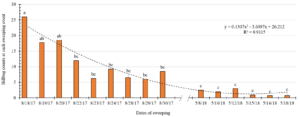
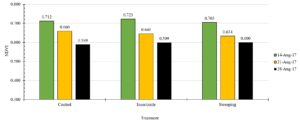
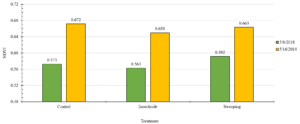
Educational & Outreach Activities
Participation Summary:
Education and outreach activities performed by the research team during the funding period included two research reports included in the University of Missouri 2017 Field Day Research Report related to billbug biology and control, one article published by the trade magazine Golf Course Management in 2017, and one poster presentation presented at the Entomology Society of America 2017 annual meeting in Denver, CO. In 2018, a peer reviewed article was published on the Environmental Entomology by the research team in this topic.
Project Outcomes
This research will result in an increased knowledge and understanding of billbug control methods, improvement of turf quality due to mechanical control methods and reduced amount of insecticides applied, and the economic benefits of using mechanical control methods over repeated applications of insecticides. This project will also increase the awareness for sod farmers and professional turf managers for adapting sustainable agriculture concept by incorporating mechanic methods for control of billbug and likely other pests. By implementing these practices, it will reduce possible negative impact to the environment, and enhance the public’s awareness towards sustainable agriculture especially in the urban environment.
Through this project, we gained a better understanding of controlling a pest without relaying solely on conventional pesticides. By introducing a mechanic approach, we also reduce the expenses associated with pesticide application, in addition to reducing risks for environmental contamination. Collectively, this approach contributes to a sustainable agriculture for sod farmers and professional turf managers. It is also important to point out that as turf is a part of people's day-to-day life, practicing sustainable agriculture on turf/sod has a direct impact in the urban environment where majority of the population resides. Therefore, a successful project like this could have a wide-spread impact to the general public.